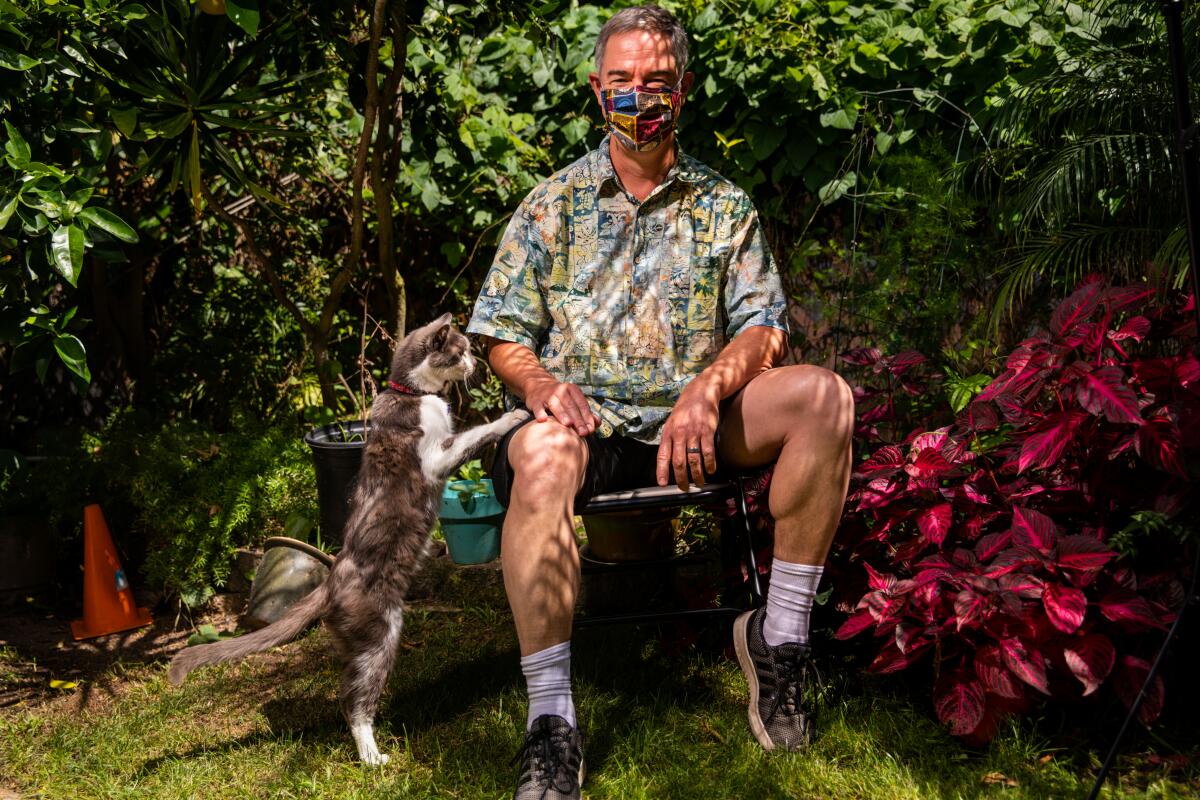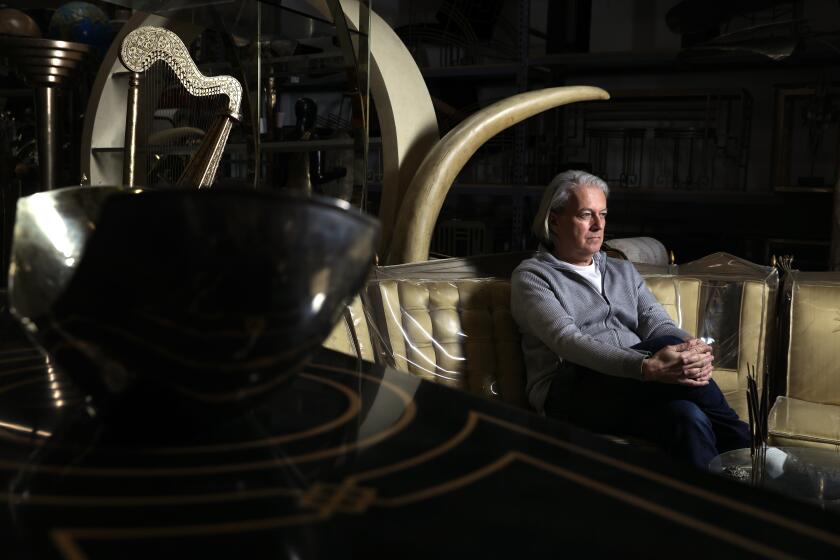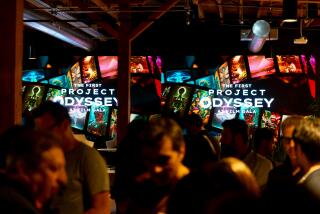How a Hollywood VFX business built a tool to fight COVID-19

- Share via
In his more than two decades as a visual effects artist, Mike O’Neal has worked on such blockbusters as “Titanic” and “Life of Pi.”
But nothing quite prepared him for his latest gig: how to visually tell the story of a deadly virus and its insidious assault on human cells — and the potential 69 drugs that could stop it.
This wasn’t a script, but a real-life mission from a group of researchers desperately trying to find a drug that can fight off the novel coronavirus, which has infected 6.3 million people worldwide and killed more than 378,260.
Researchers at San Francisco-based Krogan Lab had already identified a number of specific parts of the virus, or proteins, that latch onto proteins of human cells, so that the virus can inject its genetic material in a human cell, hijack it and make many copies to spread its infection elsewhere in the body. But even for the experts, the data was dense and hard to interpret.
To make sense of it all, they needed someone who could present the research in a more dynamic, visual way. So they turned to O’Neal and his employer, Culver City-based Zoic Labs, to marry together spreadsheets of data and convert them into interactive digital images. The goal was to help researchers identify existing human drugs that have been shown to successfully treat cancer and other diseases that affect the same human proteins that the virus attacks.
“First thing you wanted to do was take the static image and bring it to life, which is kind of what movies are about,” said O’Neal, 54. “How can we take the story that’s out there ... and make it dynamic and make it easy and interactive?”
Zoic’s work is the latest example of how companies are taking on new tasks to help the world battle the coronavirus outbreak. Car manufacturers like General Motors Co. are building ventilators, costumers are making protective masks, while rivals Google and Apple collaborated on new tools for apps that track the coronavirus’ spread.
Over the years, Zoic Labs has applied visual effects skills in projects for the U.S. Department of Defense and businesses like Capital One, where the company created an educational virtual reality experience for the bank’s employees. The work with Krogan marks Zoic’s first foray into medical research.
In about three weeks, O’Neal and his team developed a data visualization tool from the spreadsheets of data supplied by Krogan.

The map — published in the scientific journal Nature on April 30 — has been viewed by thousands of researchers in 87 countries, said Nevan Krogan, principal investigator at Krogan Lab.
“So many more scientists around the world have been looking at our data because of that tool, and that expedites research,” said Krogan, who is also a professor at UC San Francisco, where his lab is based. “And when you expedite research, you expedite treatments.”
Krogan Lab had been conducting research on how various drugs react to the novel coronavirus’ proteins, rushing to get as much testing done as possible before the pandemic shut lab facilities down in mid-March.
During that time, Krogan was also raising money for its research. Two of its donors, prominent Silicon Valley investor Ron Conway and Twitter co-founder Biz Stone, suggested Krogan explore working with Zoic Labs to take its planned static map to the next level. Stone was familiar with the company because he used to be an advisory board member at Zoic Labs.
Zoic was used to dealing with lots of data, and the donors felt the company could help the lab better visualize its map and make it more interactive.
“We’re always struggling with how to visualize the data that we generate,” Krogan said. “That’s one of the huge bottlenecks in biomedical research right now, is: How do you put different types of data together and how do you visualize it? It was just super cool to see that there are these tools available that are being used in movies in Hollywood that could be brought to bear to biomedical problems.”
Krogan was publishing a paper on its research in Nature on April 30, leaving O’Neal and his team about 30 days to create a digital tool.
“There’s a lot of data there and there’s a lot more data they wanted to put in there, but you can only fit so much stuff on a page,” O’Neal said. “Essentially, they’re trying to link all this stuff together.”
Drawing upon his years of experience working on movies, O’Neal honed in on the story researchers wanted to tell: a connection between the human proteins that the coronavirus latches onto, and drugs that have been used to treat similar viruses.
Zoic’s map illustrates 26 viral proteins and one mutant protein of the coronavirus. Researchers can zoom into one of the viral proteins and retrieve more detailed information, including a rotating 3-D image of the protein. Clicking on some of the human proteins on the map will bring up additional information on what types of drugs were used on those proteins and the status of those drugs in the market (whether they are in a clinical trial or government-approved).
“Once you hook into one particular protein, you can then follow all this information based on that protein and not have to go look it up individually in other sources,” O’Neal said. “It’s all linked together.”
Krogan and Zoic are planning to add more information to the map with more coronavirus-related research that will be published in the near future.
Zoic Labs launched seven years ago as an outgrowth of Zoic Studios, a visual effects company that started in Culver City in 2002 and is known for its work on TV shows such as “Game of Thrones,” “The Walking Dead” and “Fargo.” As the Hollywood business grew, the founders realized they could apply the same tools to other industries.
“All of a sudden we realize we’ve got scripters, coders and software programmers that can help us visualize or help other customers outside of the entertainment space to meet some of their technical or visual needs and so we saw it as an opportunity to grow and evolve,” said Zoic Studios co-founder and Zoic Labs President Tim McBride. “We can visualize things other than just maybe things that go up on the big screen.”
Zoic Labs, which employs 25 people, is expected to grow 20% to 30% in revenue this year, McBride said, declining to disclose finances. The company, which has six other projects in the works, aims to do more work in scientific research.
“We’re very fortunate that we’ve been very busy through the quarantine period,” O’Neal said. “There’s a lot of work lining up for us and a lot of work is keeping us busy now.”
With Hollywood on hold, so are the livelihoods of thousands of workers who depend on the film and TV business that has halted during the coronavirus pandemic.
For O’Neal, his work at Zoic Labs has brought him back almost full circle. The veteran visual effects designer, who has worked at Digital Domain and other companies, joined Zoic in 2017. He previously was a mechanical systems integration engineer on the Mars Pathfinder at the Jet Propulsion Laboratory in La Cañada-Flintridge. The project had a budget of $150 million. He switched careers when he found out the budget for the movie “Titanic” was even bigger.
He is no stranger to conveying complex ideas. O’Neal worked as a technical supervisor for the 2000 sci-fi film “Supernova,” in which a doctor discovers that a mysterious alien artifact brought on board a spaceship contains ninth-dimensional matter. He recalls designing one scene in which the doctor is scanning a computer screen displaying an elaborate array of actual physics formulas, which O’Neal embellished with some fancy Greek lettering for extra effect.
“We had to find a way to convey it so people could watch it without having a PhD in physics,” O’Neal said. “They were taking this alien artifact they found and analyzing it and looking at the results of the analysis on a computer screen, and then drawing conclusions from that and we had to make that plausible.”
Award-winning filmmaker Kevin Macdonald has directed many movies, including the drama “The Last King of Scotland” and thriller “State of Play.”
O’Neal believes digital visual tools will become even more important amid a pandemic that limits physical interactions.
“There’s a lot of data out there,” O’Neal said. “The future is going to be: How do you help people understand the data? We’ve been doing it for movie props. Let’s do it for your industry ... to make the digital world bigger and better.”
More to Read
Inside the business of entertainment
The Wide Shot brings you news, analysis and insights on everything from streaming wars to production — and what it all means for the future.
You may occasionally receive promotional content from the Los Angeles Times.












